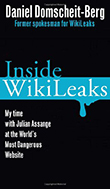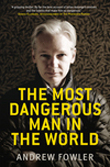 Domscheit-Berg, Daniel - Inside WikiLeaks: My Time with Julian Assange at the World's Most Dangerous Website, Crown, New York, 2011, pp. 304, ISBN-10: 030795191X
Domscheit-Berg, Daniel - Inside WikiLeaks: My Time with Julian Assange at the World's Most Dangerous Website, Crown, New York, 2011, pp. 304, ISBN-10: 030795191X
Fowler, Andrew - The Most Dangerous Man in the World, Melbourne University Press, Melbourne, 2011, pp. 271, ISBN: 052285866X, 9780522858662
Two contrasting books are on offer about the world’s most newsworthy website. Serious fans or students of the WikiLeaks phenomenon will certainly wish to read them. Less motivated readers may consider skipping both.
Daniel Domscheit-Berg (hereafter Berg – nobody is going to become famous with a surname like Domscheit) is that most dangerous of sources, a disgruntled former member of the group. He met Julian Assange early in the WikiLeaks story, and gave up his day job to work full-time on the site. He was sometimes described – to Assange’s fury – as a founding member.
He makes no bones about the fact that the parting was emotional and acrimonious. If not a spurned lover, he is at least a scarred example of the way in which so many human relationships forged in adversity can come apart under the pressures of success. Berg tries to write objectively about Julian Assange. He does not always succeed. But the reader, having been warned, can take a great deal from this book.
The author is a keen observer with a good eye for detail. WikiLeaks was, contrary to the impression it tried to give at the time, originally a very small organisation, and Berg saw a great deal of what went on. He is now (too late, alas) quite self-aware and critical about much of it. He circles round the most central question: publicity and openness are wonderful things, but some things should not be published. The delicate issue is who should decide what goes in which category. I do not claim to know the correct answer to this question, but I fancy it is not two computer geeks meeting in a Hamburg bar.
In a way, this is a story of innocence corrupted. The original idea of WikiLeaks was that documents would be published whole, on the website where anyone could read and use them. With this went a number of small rules to discourage grandstanding or discrimination. Documents were, for example, to be published strictly in the order in which they arrived.
Somehow when WikiLeaks became famous, all this seemed too much trouble. Media organisations who offered editing help in return for early access were entertained and encouraged. Selection from the vast trove of material became inevitable and there was a strong temptation, not successfully resisted, to publish the most sensational items as soon as possible. Reporters who got their noses into the trough were extremely keen to exclude rivals, with the sorry exception of The New York Times, which seems to have lost its taste for revelations which embarrass Washington, and gradually excluded itself.
Berg writes about all this ruefully, clearly, and with an engaging willingness to describe his own feelings and failings. The translation is excellent. The author is occasionally prescient. His comment about future WikiLeaks material – “I hope he’s got it somewhere safe and sound” – now seems particularly apposite. His descriptions of dealing with some of the “old media” will make some people cringe, and so they should.
Andrew Fowler is not a “Wikiperson”, former or current. He is a reporter, and his book has the virtues and vices which go with journalism. To start with it has a grossly overblown title. I am prepared to believe that WikiLeaks has some claim to be the world’s most dangerous website. After all few websites manage to be dangerous at all. It is much harder to believe that Assange is “the most dangerous man in the world.” All right, Cheney and Rumsfeld have retired, Muammar Gaddafi looks a hot candidate for a lamp post and Osama is dead.
Still, Assange does not look particularly dangerous by international standards, though perhaps a warning is in order to gullible single ladies with spare bedrooms. Assange often camps in other people’s places and, it seems, frequently gets more from his hostess than tea. Both of our writers tiptoe rather carefully round Assange’s rape case, no doubt because it is still in progress. Fowler covers a lot of ground and much of it is interesting. Assange had a spectacularly dysfunctional childhood and an interesting early history as an idealistic hacker. People who appear in Berg’s work merely as names and numbers are interviewed and described. Fowler finished his book late enough to read Berg’s, and to bring the story more up to date. So far so good.
But Fowler also has some irritating habits. Of course one wants to make the most of the story, but ‘grandiosing’ at book length leaves the reader feeling that Fowler is somewhat lacking in a sense of proportion. He also occasionally inserts a bit of speculation: nothing drastic and usually labeled with ‘probably’, but still. There are strange pointless digressions, like “When the fax machine at Twitter’s headquarters in San Francisco spat out its latest complaint just before Christmas 2010 it might have been another dissatisfied customer ... But in fact it was the latest development in the WikiLeaks investigation.” A new section starts with, “In Reykjavik the weather for August was unusually dry and warm...”
Fowler could have done with a more ruthless editor. He could also have done without the footnotes, which charitable readers may ascribe to the delusions of academic grandeur associated with being published by the Melbourne University Press. The purpose of footnotes is to enable suspicious readers to check the author’s information with its source. To have a large number of footnotes saying “author interview” is a waste of paper. Such sources can be acknowledged in the text, as they would be in ordinary newswriting. The same goes for snippets recycled from Australian newspapers. Citations of conventional media, if they must be offered, should include more precision than just the month.
The Most Dangerous Man in the World is well written and even, in places, exciting. It contains a great deal of information, though sceptical readers may fear that much of it is not very important. It gives a detailed description of Assange, whose puckish androgynous face and prematurely silver hair adorn its cover. But Assange, as they used to say of President Roosevelt, has a “heavily forested interior.”
Future historians will find Berg’s book a useful source of first-hand information. Fowler no doubt has already discovered that today’s journalism is tomorrow’s fish wrapping.
About the Reviewer
Tim Hamlett is a Professor in Journalism at Hong Kong Baptist University, Hong Kong. In the UK, he worked as a journalist for a variety of publications, including the Derby Evening Telegraph, Newcastle Journal and The Guardian. In Hong Kong, he worked for the Standard and the South China Morning Post. Professor Hamlett broadcasts occasionally for RTHK, as presenter of “The Week in Politics.”


